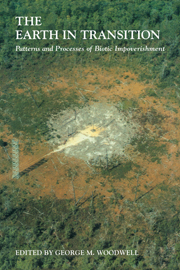Book contents
- Frontmatter
- Contents
- Preface
- Acknowledgments
- List of Contributors
- Part I Global Change and the Patterns of Impoverishment
- Part II Chronic Disturbance and Natural Ecosystems: Forests
- Part III Chronic Disturbance and Natural Ecosystems: Woodlands, Grasslands, and Tundra
- Part IV Chronic Disturbance and Natural Ecosystems: Aquatic and Emergent Ecosystems
- 18 Changes in a Red Sea Coral Community Structure: A Long-Term Case History Study
- 19 Are Deep-Sea Communities Resilient?
- 20 Species Dominance–Diversity Patterns in Oceanic Communities
- 21 Natural and Anthropogenically Imposed Limitations to Biotic Richness in Fresh Waters
- 22 Human Impacts on the South Florida Wetlands: The Everglades and Big Cypress Swamp
- 23 The Impoverishment of Aquatic Communities by Smelter Activities near Sudbury, Canada
- 24 Biotic Impoverishment: Effects of Anthropogenic Stress
- Part V Conclusion: Steps toward a World That Runs Itself
- Name Index
- Subject Index
24 - Biotic Impoverishment: Effects of Anthropogenic Stress
Published online by Cambridge University Press: 24 November 2009
- Frontmatter
- Contents
- Preface
- Acknowledgments
- List of Contributors
- Part I Global Change and the Patterns of Impoverishment
- Part II Chronic Disturbance and Natural Ecosystems: Forests
- Part III Chronic Disturbance and Natural Ecosystems: Woodlands, Grasslands, and Tundra
- Part IV Chronic Disturbance and Natural Ecosystems: Aquatic and Emergent Ecosystems
- 18 Changes in a Red Sea Coral Community Structure: A Long-Term Case History Study
- 19 Are Deep-Sea Communities Resilient?
- 20 Species Dominance–Diversity Patterns in Oceanic Communities
- 21 Natural and Anthropogenically Imposed Limitations to Biotic Richness in Fresh Waters
- 22 Human Impacts on the South Florida Wetlands: The Everglades and Big Cypress Swamp
- 23 The Impoverishment of Aquatic Communities by Smelter Activities near Sudbury, Canada
- 24 Biotic Impoverishment: Effects of Anthropogenic Stress
- Part V Conclusion: Steps toward a World That Runs Itself
- Name Index
- Subject Index
Summary
Editor's Note: Tests of theory in ecology are often difficult, sometimes impossible. John Cairns has brought a lifetime of experience to bear on the practical questions of pollution using simple aquatic systems to shed light on hypotheses in ecology that are otherwise difficult to examine. He recognizes two types of impoverishment, losses of diversity in a landscape as human effects spread, and the in situ transitions that accumulate under chronic disturbance, usually, but not always, reducing the diversity of a community and making it more vulnerable both to invasion and other disruption. The insights are refreshing, if complex and disturbing. For us they confirm the patterns now familiar: chronic disturbance in aquatic systems favors the hardy cosmopolitan species that reproduce rapidly and usually do not form the basis of complex food webs. The patterns are systematic and predictable and increasingly common. One of the greatest dangers is that the disturbances will become so close to universal that sources of species for reintroduction will be lost, despite the general hardiness of the protists with which he works.
Introduction
Anthropogenic stress commonly leads to changes in ecosystems that are regressive and best described as “impoverishment.” Most of these disturbances are chronic. Catastrophic disturbances, such as nuclear war or rapid global climatic change, will cause immediate and severe effects that we can only poorly estimate. For other disturbances, such as acid rain and various toxins, experience is abundant and data are available.
- Type
- Chapter
- Information
- The Earth in TransitionPatterns and Processes of Biotic Impoverishment, pp. 495 - 506Publisher: Cambridge University PressPrint publication year: 1991



